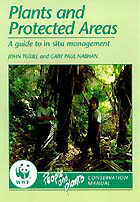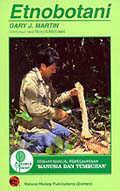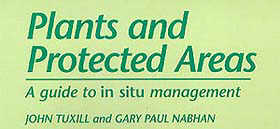|
 |
Method
Manuals
People and Plants Methods
Manuals provide guidelines on
methodologies for conservation
and community development.
The editor of the series is
Martin
Walters. Contact: Stanley
Thornes (Publishers) Ltd,
Ellenborough House, Wellington
Street, Cheltenham GL50 1YW, UK;
UK Customer Services Department,
Tel. +44.1242.267267, Fax
+44.1242.253695, e-mail cservices@thornes.co.uk
Export Customer Services
Department, Tel. +44.1242.267283,
Fax +44.1242.253695, e-mail export@thornes.co.uk
|
Three titles
are currently in print, three are being
prepared and additional ones are under
discussion:
- Ethnobotany: A
Methods Manual,
Gary J. Martin, 1995
- Plant
invaders: the threat to natural
ecosystems,
Quentin C. B. Cronk and Janice L.
Fuller, 1995.
- Plants and
protected areas: a guide to in
situ management,
John Tuxill and Gary Paul Nabhan,
1998.
- Applied ethnobotany: people,
wild plant use and conservation,
Anthony B. Cunningham, in
preparation.
- Botanical databases for
conservation and development,
Michael Berjak and Jeremy
Grimsdell, in preparation.
- Biological diversity and
traditional knowledge: the tools
of the trade, Sarah Laird, in
preparation.
| |
 |
| Ethnobotany: A Methods
Manual, Gary J. Martin, 1995.
People and Plants Conservation
Manuals, Volume 1. Originally
published by Chapman and Hall,
London; also available in Bahasa
Malaysia and Chinese; Spanish
edition in preparation. For
information on foreign language
editions, contact: Gary Martin or
Fatima Zahmoun, BP 262,
Marrakesh-Medina, Morocco; Fax
+212.4.329544, email gj_martin@compuserve.com or
peopleandplants@cybernet.net.ma
|
| |
|
 |
Ethnobotany - the
study of people's
classification,
management and use of
plants - is an endeavor
which attracts people
from various academic
disciplines.
Ethnobotanists and local
people face the
challenging task of not
only recording knowledge
of the plant world, but
also applying the results
of their studies to
biodiversity conservation
and community
development. One of their
goals is to ensure that
local natural history
becomes a living, written
tradition in communities
where it has been
transmitted orally for
many years. They are
working against time,
because indigenous
knowledge of the
environment is fast
disappearing in the face
of worldwide destruction
of natural areas and
transformation of
traditional cultures.
|
|
| This book - the first in a
new series of practical manuals
in plant conservation sponsored
by WWF, UNESCO and the Royal
Botanic Gardens, Kew - provides a
detailed overview of this
emerging discipline. Aimed
primarily at researchers who are
beginning field studies, it gives
clear descriptions of the skills
and methods most commonly
employed by ethnobotanists. It
will also be of interest to
experienced field workers who
wish to review new concepts and
techniques drawn from botany,
anthropology, economics,
ethnopharmacology and other
disciplines. The manual begins
with advice on data collection
and hypothesis testing, and ends
with practical ideas on fieldwork
ethics and the application of
research results to conservation
and community development.
Illustrated with experiences of
colleagues from around the world,
it demonstrates that the key to
excellent results is close
collaboration with local people,
conservationists and specialists
of various academic fields. The
manual:
- Describes basic skills
and techniques needed to
collect quality field
data;
- Forms part of a new
series of conservation
manuals sponsored by WWF,
UNESCO and the Royal
Botanic Gardens, Kew;
- Focuses on six academic
fields related to
ethnobotany: botany,
ethnopharmacology,
anthropology, ecology,
economics and
linguistics;
- Is written in a
non-technical style
accessible to researchers
from various academic
disciplines.
Gary J. Martin is an
anthropologist and botanist from
the USA. He is the regional
coordinator for Southeast Asia of
the People and Plants Initiative,
general editor of the People
and Plants Handbook and
Website manager of People and
Plants Online.
BACK
|
|
 |
| Plant invaders: the threat
to natural ecosystems,
Quentin C. B. Cronk and Janice L.
Fuller, 1995. People and
Plants Conservation Manuals,
Volume 2. Originally published by
Chapman and Hall, London. The
second in a new series of
practical manuals in plant
conservation sponsored by the
World Wide Fund for Nature (WWF),
UNESCO and the Royal Botanic
Gardens, Kew, this book is a
handy, practical guide to a
subject of increasing concern.
As with each of the books in
the series, Plant Invaders:
The threat to natural ecosystems
aims to give an authoritative
account of the subject in a
jargon-free style. It should
therefore be of interest not only
to the biologists studying plant
invasion, but also to land
managers and others concerned
with practical conservation.
Case studies of invasive
species highlight specific
problems from a wide range of
countries, including North
America, Africa, Australia, South
and South East Asia, Europe, and
the Pacific and Atlantic islands.
The book contains an
invaluable list of invasive
species with their countries of
origin and regions of
introduction. A full bibliography
carries references to all cited
articles and books.
Quentin Cronk is
Lecturer in Vascular Plant
Systematics at the Royal Botanic
Garden, Edinburgh and at the
Institute of Cell and Molecular
Biology, Edinburgh University,
UK. Janice Fuller is a PhD
student in palaeoecology in the
Department of Plant Sciences,
University of Cambridge, UK.
BACK
|
| |
 |
| Plants and protected
areas: a guide to in situ
management, John Tuxill and
Gary Paul Nabhan, 1998. People
and Plants Conservation Manuals,
Volume 3. Stanley Thornes,
Cheltenham. Plants and
Protected Areas is the third
in a series of practical manuals
in plant conservation sponsored
by the World Wide Fund for Nature
(WWF), UNESCO and the Royal
Botanic Gardens, Kew.
The conservation of plant
resources has sometimes been
directed disproportionally
towards seed banks and botanical
gardens. However, a comprehensive
conservation strategy should seek
to complement this off-site
approach with the in situ
management of plant resources in
their natural habitats. With the
dual aims of facilitating better
management of protected areas and
illustrating innovative
approaches to the conservation of
plant resources within their
original landscapes, the emphasis
of Plants and Protected Areas
is firmly on the practical
conservation of plant
biodiversity based on
collaboration between
conservation professionals and
local communities. Drawing on
concepts and methods from
ecology, forestry, conservation
biology, agricultural sciences,
anthropology and ethnobiology,
this book will be an invaluable
practical aid to natural resource
managers, environmental
policy-makers and conservation
biologists.
John Tuxill is a
botanist and conservationist
currently based in eastern
Panama. He is also a Research
Fellow with the Worldwatch
Institute. Gary Paul Nabhan
is Director of Science at the
Arizona-Sonora Desert Museum,
Arizona, USA.
BACK
|
| |
|
|
| Resources | About Us
| What's New
| Notice
Board | Opinion
| FAQ
| Archive
| Feedback
| Main |
 |
|
People
and Plants Online website manager: Gary J.
Martin,B.P. 262, 40008 Marrakech-Medina,
Marrakech, Morocco; Fax +212.4.329544, e-mail peopleandplants@cybernet.net.ma
Website design & maintenance by RAM Production
Sdn. Bhd.
People and Plants Online © WWF, UNESCO and Royal
Botanic Gardens, Kew |
Disclaimer
Links to other websites cited in
People and Plants Online do not imply endorsement
of these sites or their content
by the People and Plants Initiative or its
sponsoring institutions |
|